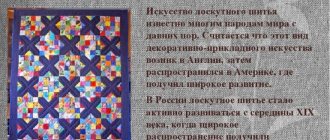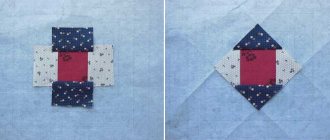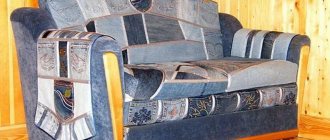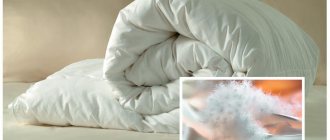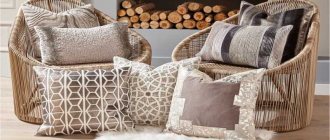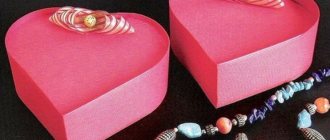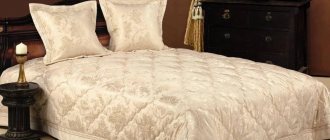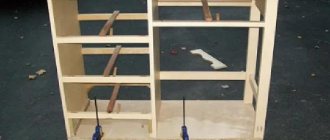Key Features
Before you start creating a patchwork quilt with your own hands, you need to take note of the characteristic features of this product, focusing on the best options.
The traditional model consists of a prefabricated face fabric, a plain backing and insulation. At the final stage, all three layers are secured with stitches that are drawn along the perimeter or diagonals of each fragment. A decorative border is sewn along the edges.
A unique aesthetic effect is achieved by design solutions that have been developed over centuries. For facial mosaics, high-quality cotton or linen fabric is used.
Uniformity in texture and a well-balanced color scheme are critical, so even with developed taste, you should study various patterns for sewing a patchwork quilt and use visual examples of the combination of patterns and colors.
Where to start?
Despite its apparent simplicity, creating a patchwork quilt is a serious challenge for beginners. For the first experiment, a scheme consisting of identical squares or their halves cut diagonally is usually used, i.e. equilateral triangles.
The maximum size of one element is 25*25 cm, the minimum is 6*6 cm, the most used is 12*12 cm. When marking the fabric, seam allowances of 1.5-2 cm are added.
Creating a Layout
After the dimensions of the finished product have been determined and the number of elements has been calculated, it is necessary to determine the principle of their arrangement.
From 3 to 9 or more different patterns (colors) are used. Traditional aesthetics rarely use plain, unpatterned patches. But you can introduce one monochrome fabric, use it for edging and as one of the elements of the main pattern.
It is not customary to add fabrics of different colors with the same pattern to the palette.
The principle of randomness in the arrangement of fragments is the main feature of patchwork products, which arose at the early stage of this style, when work on the blanket lasted many years.
The beauty of a homemade quilt largely depends on a thoughtful sewing pattern. There are no specific rules for repeatability; you can use an equal number of squares of each type, or choose some fabrics that will be repeated more often than others. This freedom allows you to create variants for already prepared material.
In any case, you will need a scaled layout of the front layer; in the case of squares, it will be a grid, each cell of which is indicated by a number, or, for greater clarity, painted over with a similar color. Identical parts can be arranged symmetrically, in the form of a diamond, a cross, a diagonal line, or in a random order.
For even distribution, you can create a repeat using all the fabrics. For example, lay out a 3 by 3 square using 9 different fabrics, and repeat this arrangement over the entire area of the product.
To emphasize variety, patches with asymmetrical patterns or striped fabrics are placed in different positions, with turns of 90 or 180 degrees.
If you are planning a large product with small details, you can assemble more complex geometric patterns using pixel patterns, using both squares and triangles.
Tips for caring for a duvet made of down and padding polyester
Filling like down is contraindicated for washing, but a blanket made of this material can last a long time if you follow some care tips:
- You should always use a duvet cover, which will serve as protection from external damage and dirt.
- When cleaning the bed, you need to shake the blanket so that it becomes fluffy and air gets inside it, which will refresh the material.
- Blankets should only be ventilated in dry weather.
- It is not recommended to wash the duvet. But if necessary, you can go to dry cleaning or wash it in a home washing machine, but in this case, after each wash, the quality of the blanket will deteriorate significantly.
- If the blanket is aired frequently, washing is only necessary if it is heavily soiled.
A blanket for the baby's discharge from the maternity hospital in the form of an envelope.
The main advantage of a blanket made of padding polyester is that it can be washed without damaging the quality of the material.
However, even when washing in a washing machine, certain rules should be followed:
- To prevent the material from bunching up in one corner when washing, you should place several tennis balls or specially designed stones in the drum of the machine.
- When the product does not have stitches, you can quilt it by hand to avoid the padding polyester from bunching up into a mass.
- When the stains cannot be washed at home, you should take the blanket to the dry cleaner, where even the most hopeless stains can be removed.
Bonbon blanket
The article discussed how to sew a duvet at home. You should not spend a large amount of money to purchase a finished product, since you can do everything yourself using the master classes from this article.
Cutting and patchwork
The main rule of a successful project is to cut out identical parts and make a neat joining, working by hand or on a sewing machine. Instead of scissors, it is more convenient to use roller knives and stencils; for complex models, special rulers for patchwork.
- Karaca Home bed linen – affordable luxury
Curtain patterns - instructions on how to sew curtains with your own hands. Step-by-step guide + master class (150 photos of new designs)
Tulle for the hall - 150 photos of the best new products and exclusive design. TOP unusual design solutions of 2020
Before sewing a patchwork quilt, you need to lay out the cut out backing fabric, smooth out all the details with an iron and place them in place according to the layout. Such a “rehearsal” will allow you to make design amendments by swapping poorly matching scraps.
If you have doubts about the quality of the fabric, you need to soak it and dry it in advance. The ideal option is when all the squares are cut from fabrics of the same quality. It is desirable that they match in thickness and composition.
An edge seam is used for connection. First, the squares are sewn to each other with strips, then the strips are connected to each other.
In order not to disturb the pattern, you can mark with threads, secure with safety pins, or simply carefully move each part.
Required Tools
When making a blanket you will need the following tools:
- Roulette;
- Tape measure;
- Awl;
- Tailor's pins;
- Threads and needle for basting;
- A piece of chalk, or dry, sharpened soap;
- Sewing machine.
Note! Additional tools may be required at the discretion of the author, but the list presented should be sufficient for simple work.
Scheme with application
Assembly and edging
The instructions for sewing a classic patchwork quilt assume the presence of padding polyester or other filler. After stitching the patchwork layer is completed, the joining seams need to be ironed from the inside out, opening the edges, then press the joints again with an iron from the front side.
The lining is secured along one side with the front part, then the filling is lined, all three layers are leveled from the center, stitched around the perimeter and secured with pins over the entire surface.
Blackout curtains: TOP-150 photos of new designs. Non-standard solutions for combining light-proof curtains in the interiorCurtains for the kitchen - 120 real photos of new designs. Options for the ideal combination of modern curtains in the kitchen interior
- How to hang curtains - step-by-step instructions with photo examples and recommendations. Exclusive curtain design solutions from experienced craftswomen
The border can be made by folding the edges of the backing onto the front surface, while the seam is masked with braid. Another option is strips of another suitable fabric that form a frame for the patchwork. You can choose another model: the entire front surface is divided into squares (triangles), which are adjacent to the edges.
The final stage of the master class is tamping, which is done on a typewriter, or, in the absence of technical capabilities, by hand. Through stitches cover all seams; additional diagonal lines are made to add volume.
To make the assembly process easier, you can abandon the insulation and make a two-layer version, increasing the thickness of the blanket due to denser fabric for the backing.
Dimensions
Since it is understandably difficult to make a bed for a blanket or to fit it to it, the blanket is sewn to the size of the bed. If your bed(s) are factory purchased, then blankets of one of the following sizes will fit it/them:
- Euro – 210x200 or 200x200 cm.
- Double, depending on the height and build of the couple - 210x180 (small skinny ones), 215x175 (plump short ones), 200x200 (average height and build), 220x240 (large ones).
- Single beds - 215x155 or 205x150.
- Single – 200x150.
- Children's - 150x120 (predominantly for boys) or 140x110 (more girlish).
- For newborns - the size of the changing table plus 12-15 cm in each direction. Typical size 120x120 cm.
The dimensions of the blanket for the existing bed are selected so that its edges (fringe, lace, frill, ruffle) on a made bed without lying down do not reach the floor by 12-15 cm, otherwise the edge of the blanket will get dirty. Also, the blanket on a free bed should not bunch up at the feet or heads, otherwise the insulation will creep. The size of the blanket determines the amount of materials needed for sewing.
Patchwork for kids
Patchwork quilted fabric symbolizes comfort and warmth, so it is ideally suited for the interior of a nursery. The baby blanket is made of cotton fabric with natural fillings. In this case, it is customary to choose pastel colors with delicate patterns, and use embroidered and openwork fragments.
For a child's or teen's quilt, you can come up with an original design using digital prints or scraps of fabric with themed designs.
- Curtain tiebacks - 150 photos of new exclusive designs
Do-it-yourself tulle - step-by-step instructions on how to sew beautiful tulle. Photos of ready-made ideas and modern design
Curtains for gray wallpaper - options for the ideal combination of curtains in a gray interior (TOP-150 photos of new designs)
In this case, both traditional schemes and adapted designs are used: one large block with the image of a cartoon character is located in the center, and a bright patchwork frame is made around it.
Results of the work performed: is there anything to be proud of?
If all the recommendations outlined today are implemented, then there will definitely be something to be proud of. The resulting blanket will not only be warm, but also beautiful. Well, with the right choice of filler, it will also become light. Here are examples of how this work should end.
Only one straight seam is visible on both sides of the edge
The patchwork quilt even looks warm, airy and light
Infinite variety
A patchwork quilt of squares, rectangles, triangles, rhombuses, circles does not exhaust the entire variety of the patchwork method. His separate direction is compositions of small single-color and patterned patches that resemble appliqué, while masters take on the most complex carpet patterns.
Another patchwork technique, which is called “crazy”, consists of sewing irregularly shaped pieces together. They resemble ordinary scraps of various configurations and sizes, which are assembled into an abstract mosaic.
Any materials can be used in patchwork - exquisite silk is intended for compositions in the Japanese style, rural style is enriched with knitted fragments, upholstery fabric produces original bedspreads that fit perfectly into a classic interior.
As a secondary use in patchwork, it is most convenient to use denim, stocks of which are available in every home.
The decorative effect is provided by contrasting compositions with floral patterns, inventive use of pockets, fragments of clothing with stripes, embroidery, etc. But we must take into account that the full use of a patchwork quilt as bedding is only possible if it is made from easily washable fabrics.
How to choose the right material
A newborn baby needs special care. The main criteria to pay attention to when choosing a material are:
- comfort;
- hypoallergenic;
- environmental friendliness;
- waterproof;
- ease of care.
The task of sewing a blanket for an adult or child is quite doable.
Based on the points, there are several fabrics used in children's things (envelope, blanket, pillow). Cotton bedding is a leader in the production of baby accessories. Firstly, this is due to the fact that the material is of plant origin. Therefore, it does not cause allergies. And it allows air to pass through well. Based on the weaving of the threads, the following types of cotton are distinguished:
- calico;
- ranfors;
- chintz;
- percale;
- satin;
- a mixture of cotton and synthetics.
The upper part of the blanket can be sewn from any fabric, but the lower part must be selected based on the criteria described above. The inner filling should not only be warm.
Your goal should be a quality, durable product that can serve you for several years.
Description of characteristics:
- Bamboo fiber. It crumples, but meets all requirements.
- Sintepon. Affordable, easy to wash, light weight and does not cause allergies.
- Sherstipon. It copes well with absorbing moisture, is soft, but cannot be washed in a machine.
- Downy. Well breathable, soft, light in weight. Disadvantages: it clumps and has a characteristic odor.
The selection of outer fabric and inner filler is the first and important stage in the entire work.
Photo of a quilt
Did you like the article? Share

1+

